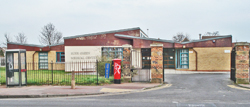Rush Green Hospital
Dagenham Road, Romford, Essex RM7 0YA
Medical dates:
Medical character:
Infectious diseases. Later, general and maternity.
The Romford Isolation Hospital opened in April 1901 with 24 beds.
It had been built by the Romford Rural and Romford Urban District
Councils and served the Romford, Dagenham and Hornchurch areas.
It was enlarged in 1906, after which it had 70 beds.
A new pavilion ward block with 8 beds for TB patients was built in 1914.
After the Becontree Estate was built by the LCC during the 1920s the Hospital was much enlarged in the 1930s to cater for the greatly increased population.
During WW2 it joined the Emergency Medical Service and became the Rush Green Emergency Hospital - a general hospital with 230 beds available for military and air-raid casualties. The Hospital buildings themselves suffered some bomb damage and, on 16th June 1944, a flying bomb destroyed a ward. Six patients and two nurses were killed.
After the war, in June 1947, a plaque commemorating the staff and patients who lost their lives in the incident was unveiled by the Minister of Health, Aneurin Bevan.
In 1948 the Hospital joined the NHS under the control of the Romford Group Hospital Management Committee, part of the North East Metropolitan Regional Hospital Board. It was renamed Rush Green Hospital and became a general hospital with 180 beds. The old open wards were considered unsuitable for fever patients, but one remained open, under protest, for scarlet fever patients, while two became used for TB patients, and one was closed due to insufficient staff (but probably would have been used for TB patients if there had been enough nurses).
In 1957 the Hospital had 301 beds. A Polio Unit was established as there had been an epidemic of the disease during the 1950s.
By 1966 there were 316 beds for general and infectious diseases patients, including the Polio Unit. In May 1969 a new 5-story maternity unit with 115 beds was officially opened by the Duchess of Kent. It had cost £829,000 to build and equip.
In 1972 there were 409 beds. The maternity block contained 78 obstetric and 55 gynaecological beds. A Special Care Baby Unit for premature babies had also been established.
Following a major reorganisation of the NHS in 1974, the Hospital came under the control of the Barking District Health Authority, part of the North East Thames Regional Health Authority.
In 1982, after another reorganisation of the NHS, the Hospital was administered by the Barking, Havering and Brentwood District Health Authority. It had 397 beds.
By 1990 it had 345 beds. Maternity services were moved to Harold Wood Hospital and, in 1994, the local Health Authority decided to close the Hospital, despite local opposition.
A new pavilion ward block with 8 beds for TB patients was built in 1914.
After the Becontree Estate was built by the LCC during the 1920s the Hospital was much enlarged in the 1930s to cater for the greatly increased population.
During WW2 it joined the Emergency Medical Service and became the Rush Green Emergency Hospital - a general hospital with 230 beds available for military and air-raid casualties. The Hospital buildings themselves suffered some bomb damage and, on 16th June 1944, a flying bomb destroyed a ward. Six patients and two nurses were killed.
After the war, in June 1947, a plaque commemorating the staff and patients who lost their lives in the incident was unveiled by the Minister of Health, Aneurin Bevan.
In 1948 the Hospital joined the NHS under the control of the Romford Group Hospital Management Committee, part of the North East Metropolitan Regional Hospital Board. It was renamed Rush Green Hospital and became a general hospital with 180 beds. The old open wards were considered unsuitable for fever patients, but one remained open, under protest, for scarlet fever patients, while two became used for TB patients, and one was closed due to insufficient staff (but probably would have been used for TB patients if there had been enough nurses).
In 1957 the Hospital had 301 beds. A Polio Unit was established as there had been an epidemic of the disease during the 1950s.
By 1966 there were 316 beds for general and infectious diseases patients, including the Polio Unit. In May 1969 a new 5-story maternity unit with 115 beds was officially opened by the Duchess of Kent. It had cost £829,000 to build and equip.
In 1972 there were 409 beds. The maternity block contained 78 obstetric and 55 gynaecological beds. A Special Care Baby Unit for premature babies had also been established.
Following a major reorganisation of the NHS in 1974, the Hospital came under the control of the Barking District Health Authority, part of the North East Thames Regional Health Authority.
In 1982, after another reorganisation of the NHS, the Hospital was administered by the Barking, Havering and Brentwood District Health Authority. It had 397 beds.
By 1990 it had 345 beds. Maternity services were moved to Harold Wood Hospital and, in 1994, the local Health Authority decided to close the Hospital, despite local opposition.
Present status (February 2008)
The site has been partly redeveloped for health and social care. It now contains a Medical Centre and a nursing home - Chaseview. The remainder of the site has been used for housing, built by Bellway Homes. The new streets are named after flowers.

Rush Green Medical Centre at 261 Dagenham Road.


Looking north on Dagenham Road (left) Seen from Dagenham Road on the south (right).


The corner of Camomile Road (left).

Looking into Campion Close.


Chaseview Residential and Nursing Home with 120 rooms was built in 1997 and is run by BUPA. It consists of four houses.
(Author unstated) 1947 Nursing echoes. British Journal of Nursing (July), 81.
http://en.wikipedia.org
www.freewebs.com
http://hansard.millbanksystems.com
www.british-history.ac.uk
Return to home page